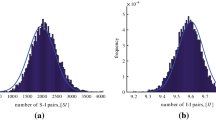Abstract
We study the phase diagram of the standard pair approximation equations for two different models in population dynamics, the susceptible-infective-recovered-susceptible model of infection spread and a predator-prey interaction model, on a network of homogeneous degree k. These models have similar phase diagrams and represent two classes of systems for which noisy oscillations, still largely unexplained, are observed in nature. We show that for a certain range of the parameter k both models exhibit an oscillatory phase in a region of parameter space that corresponds to weak driving. This oscillatory phase, however, disappears when k is large. For k = 3, 4, we compare the phase diagram of the standard pair approximation equations of both models with the results of simulations on regular random graphs of the same degree. We show that for parameter values in the oscillatory phase, and even for large system sizes, the simulations either die out or exhibit damped oscillations, depending on the initial conditions. We discuss this failure of the standard pair approximation model to capture even the qualitative behavior of the simulations on large regular random graphs and the relevance of the oscillatory phase in the pair approximation diagrams to explain the cycling behavior found in real populations.
Similar content being viewed by others
References
J.D. Murray, Mathematical Biology I: An Introduction (Springer-Verlag, New York, 2002)
R.M. Anderson, R.M. May, Infectious Diseases of Humans: Dynamics and Control (Oxford University Press, Oxford, 1991)
The Geometry of Ecological Interactions: Simplifying Spatial Complexity, edited by U. Dieckmann, R. Law, J.A.J. Metz (Cambridge University Press, Cambridge, 2000)
M.J. Keeling, K.T.D. Eames, J. R. Soc. Interface 2, 295 (2005)
H. Matsuda, N. Ogita, A. Sasaki, K. Sato, Prog. Theor. Phys. 88, 1035 (1992)
S. Levin, R. Durrett, Phil. Trans. R. Soc. Lond. B 351, 1615 (1996)
M.J. Keeling, D.A. Rand, A.J. Morris, Proc. R. Soc. Lond. B 264, 1149 (1997)
M. van Baalen, in The Geometry of Ecological Interactions: Simplifying Spatial Complexity, edited by U. Dieckmann, R. Law, J.A.J. Metz (Cambridge University Press, Cambridge, 2000), p. 359
G. Rozhnova, A. Nunes, Phys. Rev. E 79, 041922 (2009)
D. A. Rand, in Advanced Ecological Theory: Principles and Applications, edited by J. McGlade (Blackwell Science, Oxford, 1999), p. 100
A.J. Morris, Ph.D. dissertation, University of Warwick, Coventry, UK (1997)
J. Benoit, A. Nunes, M.M. Telo da Gama, Eur. Phys. J. B 50, 177 (2006)
G. Rozhnova, A. Nunes, in Complex Sciences: Complex 2009, Part I, LNICST 4, edited by J. Zhou (Springer Berlin Heidelberg, 2009), p. 792
J. Joo, J.L. Lebowitz, Phys. Rev. E 70, 036114 (2004)
J.E. Satulovsky, T. Tomé, Phys. Rev. E 49, 5073 (1994)
T. Tomé, K.C. de Carvalho, J. Phys. A: Math. Theor. 40, 12901 (2007)
Z. Nikoloski, N. Deo, L. Kucera, Complexus 3, 169 (2006)
E. Volz, L.A. Meyers, Proc. R. Soc. B 274, 2925 (2007)
G. Rozhnova, A. Nunes, Phys. Rev. E 80, 051915 (2009)
C.T. Bauch, D.J.D. Earn, Proc. R. Soc. London, Ser. B 270, 1573 (2003)
C.S. Elton, Voles, Mice and Lemmings: Problems in Population Dynamics (Clarendon Press, Oxford, 1942)
C.B. Huffaker, Hilgardia 27, 343 (1958)
J.O. Wolff, Ecological Monographs 50, 111 (1980)
A. Lotka, J. Am. Chem. Soc. 42, 1595 (1920)
V. Volterra, Leçons sur la Théorie Mathématique de la Lutte pour la Vie (Gauthier-Villars, Paris, 1931)
A. Lipowski, Phys. Rev. E 60, 5179 (1999)
T. Antal, M. Droz, Phys. Rev. E 63, 056119 (2001)
M. Mobilia, I.T. Georgiev, U.C. Täuber, J. Stat. Phys. 128, 447 (2007)
M. Peltomäki, M. Rost, M. Alava, Phys. Rev. E 78, 050903(R) (2008)
S. Boutin, Wildl. Res. 22, 89 (1995)
A.B. Bortz, M.H. Kalos, J.L. Lebowitz, J. Comput. Phys. 17, 10 (1975)
D.T. Gillespie, J. Comput. Phys. 22, 403 (1976)
G. Szabó, A. Szolnoki, R. Izsák, J. Phys. A 37, 2599 (2004)
A. Szolnoki, G. Szabó, Phys. Rev. E 70, 037102 (2004)
E. Pugliese, C. Castellano, e-print [arXiv:0903.5489]
Author information
Authors and Affiliations
Corresponding author
Rights and permissions
About this article
Cite this article
Rozhnova, G., Nunes, A. Population dynamics on random networks: simulations and analytical models. Eur. Phys. J. B 74, 235–242 (2010). https://doi.org/10.1140/epjb/e2010-00068-7
Received:
Revised:
Published:
Issue Date:
DOI: https://doi.org/10.1140/epjb/e2010-00068-7




